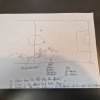
Hello Everyone,
Please can you help me with this offside I called as AR. I have attached an image.
Basics are: The Attacker came back from behind the defence to get a ball that was kicked forward from a team mate. He got to the ball as a defender was getting there and got to the ball first in his own half!
I watched and flagged from the position he set off from as he got to the ball with the defender.
My questions are these.
Q. Where do I flag the offside?
ie where he set off from, or should I have followed him down the line and flagged as he got to the ball with the defender?
The answer to the above question may then clarify where the indirect freekick is taken from.
Also, if I was right to flag from where he started his run as he got to the ball with the defender does the referee decide where the indirect kick goes from ie the set off point or where he got to the ball and which should he pick?
In the game the referee gave the offside I flagged and it was from the set off point. I asked him about it after the game, and he went with the set off point as the point when the player got involved in active play, I am not sure so I am throwing it open for clarification.
Your expert guidance here will be much appreciated. I hope it makes sense OK.
Kindest regards
Graham
(Just completed season 1 as referee and keen to progress and get it right!)


